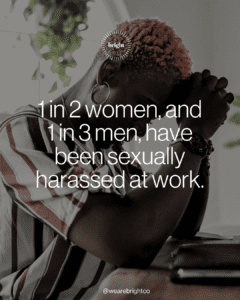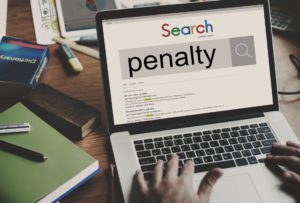“The system is broken but passing my bill is a massive step towards fixing it.”- WeraHobhouse, Member of Parliament for Bath
At the end of 2023, after years of lobbying by stakeholders, and led by Wera Hobhouse, MP, the UK government passed new legislation, with the aim of safeguarding our workplaces by better protecting people from sexual harassment at work. The Worker Protection Act 2023 prioritises prevention of sexual harassment by requiring all employers to “take reasonable steps to prevent sexual harassment of employees in the course of their employment” including at workplace social events, and when working outside the office.
The campaign for this change was undertaken by a broad coalition of interested parties including, amongst others, Amnesty International, Business in the Community, and UK trade unions. This diverse collective named themselves the, “This Is Not Working Alliance” – a title that reflects the view that our current systems are failing to deal with the problem of sexual harassment at work.

You might have witnessed indications of this failure – in news coverage, social media discourse, in private conversations, or personal experience – and the data is damning. Research shows us that:
• 1 in 2 women, and 1 in 3 men, have been sexually harassed at work
• Rates of sexual harassment are even higher for people of colour, and disabled people
• 2 in 3 LGBTQ workers have experienced sexual harassment in the workplace
• 4 out of 5 people sexually harassed at work don’t report it.
In summary, “the harsh reality is that workplace cultures allow sexual harassment to thrive”.
It is this bleak landscape that the Worker Protection Act proposes to transform. In this piece we’ll unpack its potential impact, and implications – for victims of sexual harassment, as well as for business leaders, and HR professionals tasked with making the changes. To do that, it’s helpful to first take a look at what accounts for the apparent systemic failure to protect people from workplace sexual harassment in the UK.
In 2023, ACAS brought together a group of representatives of major employers, social partners, and trade unions, to understand what’s going wrong when it comes to sexual harassment at work. Some of the groups key insights included:
• Workplaces don’t create a psychologically safe space which allows all staff to be themselves, so disclosure of harassment is rare
• Some ‘solutions’ make things worse if they’re not fully committed to (for example, a ‘zero tolerance’ policy will quickly lose the trust of employees if one person goes unheard, ‘champions’ only have true value if they have clear objectives and accountability)
• Money is perceived to outweigh people so problems are not aired – for example companies celebrating high-performing income-generating staff, no matter their behaviour
• A clear line of sight for effective reporting can be difficult, particularly for larger employers working in multiple countries.
The new legislation proposes to make change by requiring employers, not only to implement effective reporting, and remedial, measures when sexual harassment occurs, but to demonstrate how they are actively shaping cultures which prevent it from happening. The Equalities and Human Rights Commission will be able to take enforcement action against firms that breach this duty, and employers who fail to prevent sexual harassment towards an employee, can also face significant financial repercussions.

This preventative focus has been widely welcomed. It’s hoped that employers will be incentivised to ensure workplace policies, and practices, prioritise protection from sexual harassment. However, for those of us who are invested in building healthy workplace cultures, where everyone can thrive, there are two significant concerns. Firstly, the Worker Protection Act does not extend to work with third parties – like customers or clients. For a whole range of victims of sexual harassment, from those who serve on shop floors, to people brokering multi-million-pound deals over dinner and drinks, it’s this part of the workplace culture that needs to change the most. The second concern as summarised by ACAS is “employers are not yet ready and need help in preparing for the change”.
So, how can leaders ensure that their businesses meet the requirements of the new law, capitalise on the opportunity for change that it represents, and plug some of the gaps that it does not address? In my opinion, as a specialist in sexual violence but also a people manager, the real impact of the Act will stand or fall on the commitment of leaders to fostering healthy workplace relationships in every area of the business. Compliance with the new law demands pro-activity, four key actions for leaders and HR professionals between now and October 2024 will be:
- Policy Review: Ensuring that HR policies actively promote healthy workplace relationships, guard against abuse of power, and are clear about recourse and remedy where harassment occurs.
- Communications: Aligning all messaging (including through people managers) about sexual harassment – informing people at every level that the problem of sexual harassment is understood, and there are measures in place to prevent, and address, it.
- Reporting and recourse: Putting procedures in place that are accessible for employees at every level, that take account of the needs of those who are most vulnerable, and making sure that people know how to report, and what happens after they do.
- Learning & Development: Managers and HR will need training in the change to the law, but a really effective L&D programme will also include a suite of interventions to promote a healthy workplace culture, in which sexual harassment is less likely to happen. Learning opportunities that foster psychological safety and workplace inclusion should reference sexual harassment, and equip employees to recognise and report it.

Critically, for any of these measures to be truly effective, they must be underpinned by listening to employee experiences of the workplace. Employee voice mechanisms, such as staff surveys, worker forums, employee focus groups, and insight workshops are all ways for leaders to learn about:
• Danger-zones for sexual harassment in their workplace.
• The scale of the problem, and the impact on employees and the business.
• What policies and practices are needed, and whether they’re working.
One of the most difficult aspects of sexual harassment for those who experience it, and those who wish to tackle it, is the way in which it silences, and isolates people. Leaders who listen have the power to ensure that no one is left to prevent or manage sexual harassment alone.
Elizabeth Noble is a psychotherapist, executive coach and specialist in trauma-informed spaces. Elizabeth works within the Bright Collective as both a strategic consultant and trainer delivering programs and workshops that cover specialist areas such as: healthy leadership, LGBTQIA+ support, domestic violence, resilience, and substance use.
Want to find out more about creating psychological safety, how to foster an environment that truly listens to employee voices and create healthy workplace relationships? Say ‘[email protected]’
[1] The TUC; Government Equalities Office Sexual Harassment Survey 2020 [1] The Fawcett Society [1] ACAS – an independent public body, sponsored by the UK Government and responsible for improving employment relations


